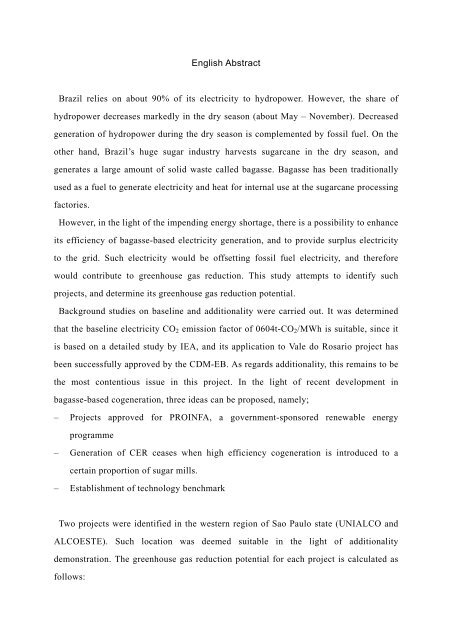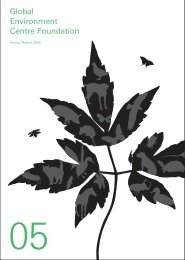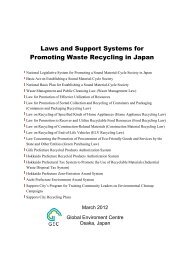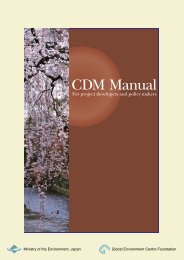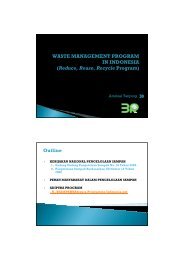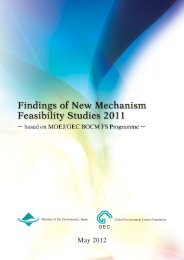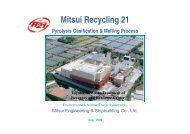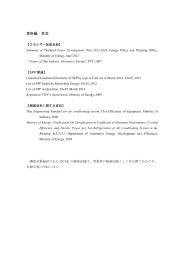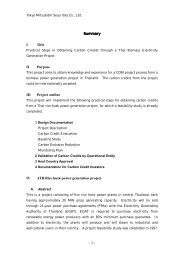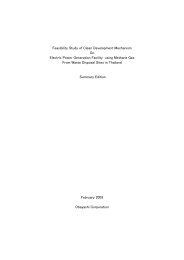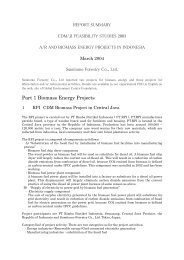Brazillian Sugar Industry Waste-to-energy Project
Brazillian Sugar Industry Waste-to-energy Project
Brazillian Sugar Industry Waste-to-energy Project
- No tags were found...
Create successful ePaper yourself
Turn your PDF publications into a flip-book with our unique Google optimized e-Paper software.
English AbstractBrazil relies on about 90% of its electricity <strong>to</strong> hydropower. However, the share ofhydropower decreases markedly in the dry season (about May – November). Decreasedgeneration of hydropower during the dry season is complemented by fossil fuel. On theother hand, Brazil’s huge sugar industry harvests sugarcane in the dry season, andgenerates a large amount of solid waste called bagasse. Bagasse has been traditionallyused as a fuel <strong>to</strong> generate electricity and heat for internal use at the sugarcane processingfac<strong>to</strong>ries.However, in the light of the impending <strong>energy</strong> shortage, there is a possibility <strong>to</strong> enhanceits efficiency of bagasse-based electricity generation, and <strong>to</strong> provide surplus electricity<strong>to</strong> the grid. Such electricity would be offsetting fossil fuel electricity, and thereforewould contribute <strong>to</strong> greenhouse gas reduction. This study attempts <strong>to</strong> identify suchprojects, and determine its greenhouse gas reduction potential.Background studies on baseline and additionality were carried out. It was determinedthat the baseline electricity CO 2 emission fac<strong>to</strong>r of 0604t-CO 2 /MWh is suitable, since itis based on a detailed study by IEA, and its application <strong>to</strong> Vale do Rosario project hasbeen successfully approved by the CDM-EB. As regards additionality, this remains <strong>to</strong> bethe most contentious issue in this project. In the light of recent development inbagasse-based cogeneration, three ideas can be proposed, namely;– <strong>Project</strong>s approved for PROINFA, a government-sponsored renewable <strong>energy</strong>programme– Generation of CER ceases when high efficiency cogeneration is introduced <strong>to</strong> acertain proportion of sugar mills.– Establishment of technology benchmarkTwo projects were identified in the western region of Sao Paulo state (UNIALCO andALCOESTE). Such location was deemed suitable in the light of additionalitydemonstration. The greenhouse gas reduction potential for each project is calculated asfollows:
Table 1. GHG reduction potential 40 61 11 29 153,000 273,000 48,000 144,000 92,412t-CO 2 164,892t-CO 2 28,992t-CO 2 78,278t-CO 2For ALCOESTE which is expanding its capacity, it was determined that, forintroduction of a 60kgf/cm 2boiler (standard new technology), CDM was deemedsuitable for only existing part of the plant, whereas entire project was deemed eligiblefor introduction of a 80kgf/cm 2 boiler (higher than standard new technology)Internal rate of return (IRR) was calculated as follows:Table 2. IRR of the projects 9.2% 10.5% 6.3% 7.4% 10.9% 12.3% 7.5% 8.6% 13.1% 16.0% 7.4% 9.5% 16.9% 20.5% 9.6% 12.0%Result of the sensitivity analysis is as follows:
Table 3. Sensitivity analysis of the projects 9.2% 13.1% 10.0% 14.8% 11.8% 19.2% 4.1% 2.9% 5.6% 5.4% 15.6% 29.2% 16.8% 32.7% 4.7% 4.5% 5.7% 6.2% 9.2% 10.2% 10.5% 12.7%Potential measures <strong>to</strong> enhance GHG reduction such as increased operating time,introduction of BIG-GT (gasification turbine), heat provision, introduction ofmechanized harvesting coupled with use of harvested trash are deemed unsuitable in theface of safety, increased cost and potential employment loss.Environmental impact is not deemed <strong>to</strong> be a problem in the light of its location, nature(efficiency improvement of generation), subjected <strong>to</strong> EIA regulation of Sao Paulo stateand necessary measures such as erection of high stacks and waste water treatment. Localstakeholder involvement is also not problematic in the view of its location, improvemen<strong>to</strong>f <strong>energy</strong> security and no loss of employment.It was concluded that use of bagasse as a cogeneration fuel <strong>to</strong> provide electricity <strong>to</strong> thegrid is a hopeful CDM candidate, in the light of its substantial potential (c. 6,000MW),though demonstration of additionality remains an issue since such generation isbecoming common among the more entrepreneurial of the sugar mills. A considerablenumber of mills, however, it can also be said that a considerable number of mills are notin a position <strong>to</strong> readily enter in<strong>to</strong> such business.The research team has been cooperating with UNICA (sugar mill organization of SaoPaulo State) as well as UNDP, which oversees much of policy implementation in Brazil.Thus, the research team is currently in a good position <strong>to</strong> establish a scheme <strong>to</strong> identifyCDM projects and produce PDDs that can gain support of the Brazilian sugar industryand the government. Therefore, continued support <strong>to</strong>wards a fruitful cooperation with an
aim <strong>to</strong> operationalize the Japanese-Brazilian utilization of CDM is desirable.


